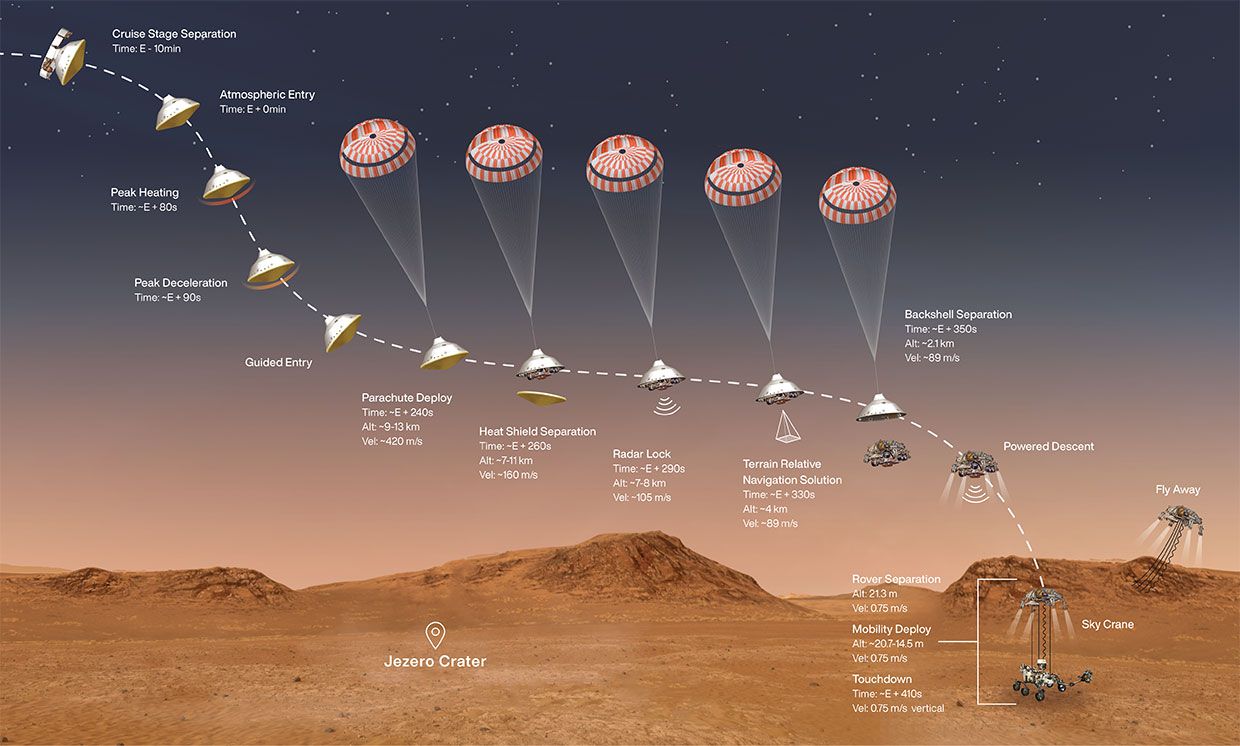No Sleep Till Jezero: Touchdown for Mars Perseverance Rover!
They used to call it Seven Minutes of Terror"-a NASA probe would slice into the atmosphere of Mars at more than 20,000 kilometers per hour; slow itself with a heat shield, parachute, and rocket engines; and somehow land intact on the surface, just six or seven minutes later, while its makers waited helplessly on Earth. The computer-animated landing videos NASA produced before previous Mars missions-in 2004, 2008, and 2012-became online sensations. If any one thing doesn't work just right," said NASA engineer Tom Rivellini in the last one, it's game over."
NASA is now trying again, with the Perseverance rover and the tiny Ingenuity drone bolted to its undercarriage. NASA will be live-streaming the landing (across many video and social media platforms as well as in a Spanish language feed and in an immersive, 360-degree view) beginning at 11:15 a.m. PST/2:15 p.m. EST/19:15 UTC on Thursday, 18 February 2021.
While this year's animated landing video is as dramatic as ever, the tone has changed. The models and simulations of landing at Jezero crater have assessed the probability of landing safely to be above 99 percent," says Swati Mohan, the guidance, navigation and controls operations lead for the mission.
There isn't a trace of arrogance in her voice as she says this. She's been working on this mission for five years, has teammates who were around for NASA's first Mars rover in 1997, and knows what they're up against. Yes, they say, 99 percent reliability is realistic.
The biggest advance over past missions is a system called Terrain Relative Navigation-TRN for short. In essence, it gives the spacecraft a way to know precisely where it's headed, so it can steer clear of hazards on the very jagged landscapes that scientists most want to explore. If all goes as planned, Perseverance will image the Martian surface in rapid sequence as it plows toward its landing site, and compare what it sees to onboard maps of the ground below. The onboard database is primarily based on high-resolution images from NASA's Mars Reconnaissance Orbiter, which has been mapping the planet from an altitude of 250 kilometers since 2006. Its images have a resolution of 30 cm per pixel.
This is kind of along the same lines as what the Apollo astronauts did with people in the loop, back in the day. Those guys looked out the window," says Allen Chen, the mission's entry, descent, and landing lead. For the first time here on Mars, we're automating that."
 Illustration: NASA/JPL-Caltech NASA's Perseverance Mars mission follows a carefully choreographed sequence of steps, pictured here, that-with many engineers on the ground holding their breath-will hopefully end in the newest Mars rover ready to explore the red planet.
Illustration: NASA/JPL-Caltech NASA's Perseverance Mars mission follows a carefully choreographed sequence of steps, pictured here, that-with many engineers on the ground holding their breath-will hopefully end in the newest Mars rover ready to explore the red planet. There will still be plenty of anxious controllers at NASA's Jet Propulsion Laboratory in California. After all, the spacecraft will be on its own, about 209 million kilometers from Earth, far enough away that its radio signals will take more than 11 minutes to reach home. The ship should reach the surface four minutes before engineers even know it has entered the Martian atmosphere. Landing on Mars is hard enough," says Thomas Zurbuchen, NASA's associate administrator for science missions. It is not guaranteed that we will be successful."
But the new navigation technology makes a very risky landing possible. Jezero crater, which was probably once a lake at the end of a river delta, has been on scientists' shortlist since the 1990s as place to look for signs of past life on Mars. But engineers voted against it until this mission. Previous landers used radar, which Mohan likens to closing your eyes and holding your hands out in front of you. You can use that to slow down and to stop. But with your eyes closed you can't really control where you're coming down."
Everything happens fast as Perseverance comes in, following a long arcing path. Fewer than 90 seconds before scheduled touchdown, and about 2,100 meters above the Martian surface, the TRN system makes its calculations. Its rapid-fire imaging should by then have told it where it is relative to the ground below, and from that it can project its likely touchdown spot. If the ship is headed for a ridge, a crevice, or a dangerous outcropping of rock, the computer will send commands to eight downward-facing rocket engines to change the descent trajectory.
In that final minute, as the spacecraft slows from 300 kilometers per hour to zero, the TRN system can shift the touchdown spot by up to 330 meters. The safe targets map in Perseverance's memory is detailed enough, the team says, that the ship should be able to reach a suitable location for a safe landing.
It's able to thread the needle of all these different hazards to land in the safe spots in between these hazards," says Mohan, and by landing amongst the hazards it's also landing amongst the scientific features of interest."
Update as of 3:55 p.m. EST, 18 Feb. 2021: Perseverance has landed!
I'm safe on Mars. Perseverance will get you anywhere.
- NASA's Perseverance Mars Rover (@NASAPersevere) February 18, 2021
#CountdownToMars